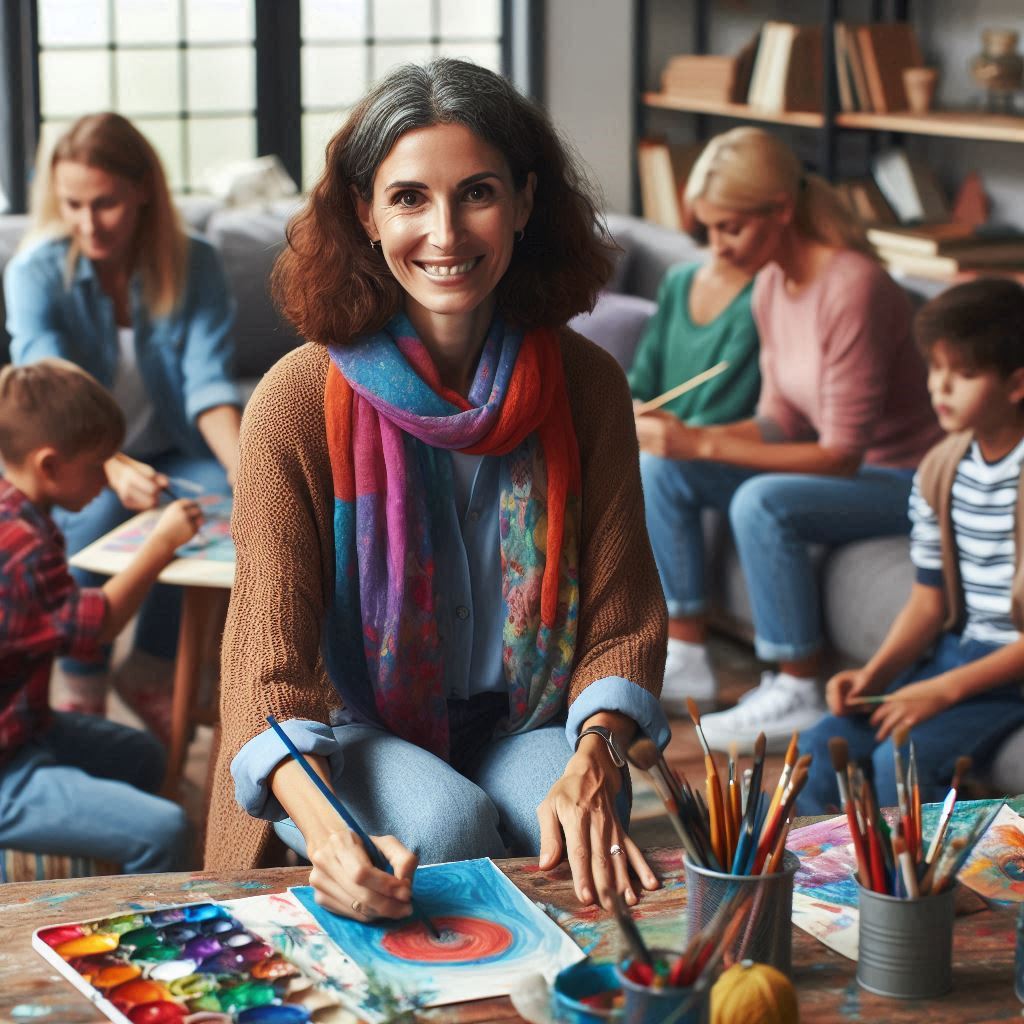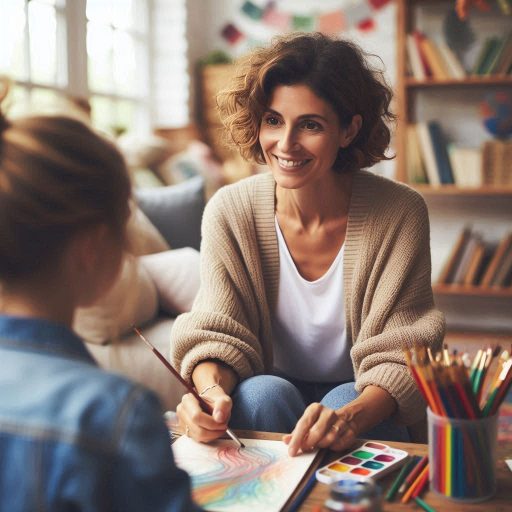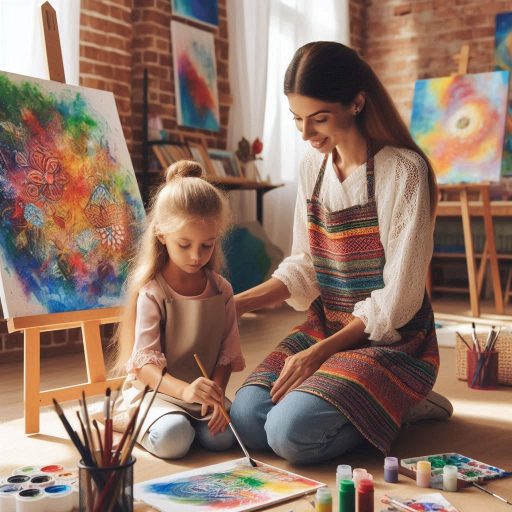Introduction
Art therapy is a therapeutic practice that uses creative processes to help individuals express their feelings, cope with stress, and enhance their emotional well-being.
It combines the principles of psychology and art, allowing people to create visual representations of their thoughts and emotions.
By engaging in artistic activities, individuals can explore their feelings in a non-verbal way, making it particularly useful for those struggling with anxiety and stress.
Art therapy can be highly effective in overcoming anxiety and stress.
It provides a safe outlet for individuals to express their emotions, reducing feelings of isolation and promoting self-discovery.
The act of creating art can help distract from negative thoughts and foster mindfulness, allowing individuals to focus on the present moment.
The benefits of using art therapy as a form of self-expression and stress relief are numerous.
It can enhance emotional awareness, improve problem-solving skills, and boost self-esteem.
Moreover, the creative process can induce a sense of relaxation, helping to lower stress levels and promote overall mental well-being.
Through art therapy, individuals can harness the power of creativity to navigate their emotions and find peace within themselves.
Understanding Anxiety and Stress
Describe the Symptoms of Anxiety and Stress
Anxiety and stress manifest through various physical and emotional symptoms.
Individuals often experience excessive worry and fear about daily situations.
Common physical symptoms include increased heart rate, muscle tension, and headaches.
Some may experience digestive issues, fatigue, or difficulty sleeping.
Emotional symptoms often include irritability, restlessness, and difficulty concentrating.
Many people report feeling overwhelmed by their thoughts and emotions.
These symptoms can vary in intensity, ranging from mild discomfort to severe distress.
Some individuals may also experience panic attacks, which can feel debilitating.
Recognizing these symptoms is the first step in managing anxiety and stress effectively.
The Impact of Anxiety and Stress on Mental Health
Anxiety and stress significantly impact mental health.
Prolonged exposure to stress can lead to anxiety disorders and depression.
Individuals may struggle with daily activities and find it challenging to maintain relationships.
Chronic anxiety can result in feelings of hopelessness and helplessness.
The effects of stress extend beyond mental health.
Stress can weaken the immune system, making individuals more susceptible to illness.
It can also lead to unhealthy coping mechanisms, such as substance abuse or overeating.
These behaviors can further exacerbate mental health issues, creating a cycle that is hard to break.
Addressing anxiety and stress is vital for improving mental health.
Early intervention can prevent these issues from escalating.
Seeking help and employing coping strategies can lead to better emotional regulation and overall well-being.
The Importance of Addressing Anxiety and Stress for Overall Well-being
Addressing anxiety and stress is essential for overall well-being.
Individuals who manage these challenges effectively experience improved quality of life.
They report better relationships, enhanced productivity, and greater satisfaction in their daily activities.
Ignoring anxiety and stress can lead to long-term consequences.
Individuals may miss out on opportunities for personal growth and fulfillment.
Proactive management of these conditions fosters resilience and emotional strength.
Art therapy provides a creative outlet for expressing emotions related to anxiety and stress.
Engaging in artistic activities allows individuals to process their feelings in a safe environment.
This form of therapy encourages self-reflection and promotes relaxation.
Understanding anxiety and stress is crucial for mental health.
Recognizing symptoms helps individuals seek appropriate support.
Addressing these issues leads to improved overall well-being.
By incorporating therapies like art therapy, individuals can manage their anxiety and stress effectively.
Taking these steps fosters a healthier, more balanced life.
Read: Character Design Trends: What’s Hot in 2024?
How Art Therapy Works
How Art Therapy Allows Individuals to Express Their Emotions Through Art
Art therapy provides a unique avenue for individuals to express their emotions.
Through various art forms, such as painting, drawing, or sculpting, individuals can communicate feelings that may be difficult to articulate verbally.
The creative process allows for self-exploration and emotional release.
Participants often find that creating art can help them visualize their thoughts and emotions.
This visualization fosters deeper insights into their experiences and challenges.
Art therapy encourages freedom of expression without judgment, allowing individuals to explore their feelings safely.
As clients engage with different materials and techniques, they can convey complex emotions.
This process can be particularly beneficial for those who struggle with traditional talk therapy.
The Therapeutic Benefits of Engaging in Creative Activities
Engaging in creative activities has numerous therapeutic benefits.
Creating art can serve as a powerful coping mechanism, helping individuals manage stress and anxiety.
The act of making art can be meditative, allowing individuals to enter a state of flow.
This state of flow can help reduce feelings of overwhelm and distraction.
Participants often report feeling a sense of accomplishment and pride in their creative work.
Art therapy also fosters problem-solving skills, as individuals learn to navigate challenges within their artistic process.
Moreover, engaging in creative activities can improve mood and promote positive emotions.
Research indicates that creating art releases endorphins, which contribute to feelings of happiness and relaxation.
The Role of Art Therapy in Promoting Mindfulness and Relaxation
Art therapy plays a significant role in promoting mindfulness and relaxation.
The creative process encourages individuals to focus on the present moment, enhancing their awareness and connection to their feelings.
This mindfulness aspect can lead to reduced anxiety and stress levels.
Participants often report feeling calmer and more centered after engaging in art-making activities.
The repetitive motions involved in certain art forms can also induce a calming effect, similar to meditation.
Additionally, art therapy provides a structured environment for individuals to process their emotions.
This structure can help individuals feel more secure and supported during their creative journey.
Art therapy enables individuals to express emotions, offering therapeutic benefits through creative activities.
It promotes mindfulness and relaxation, making it a valuable tool for enhancing emotional well-being.
By embracing the creative process, individuals can cultivate self-awareness, reduce anxiety, and achieve a greater sense of peace.
Read: How to Price Your Ceramic Artwork
Types of Art Therapy Techniques
Different Art Therapy Techniques Such as Painting, Drawing, and Sculpting
Art therapy encompasses various techniques, each offering unique benefits for emotional expression and healing.
Painting allows individuals to explore color and form, facilitating emotional exploration.
Drawing provides a direct means of visual expression, allowing for spontaneity and creativity.
Sculpting involves three-dimensional creativity, which can enhance tactile engagement and sensory awareness.
Other techniques, such as collage and mixed media, enable individuals to combine different materials and ideas.
Each art form provides a distinct way to express feelings and thoughts, making art therapy versatile and adaptable to individual preferences.
How Each Technique Can Help in Managing Anxiety and Stress
Each art therapy technique offers specific benefits in managing anxiety and stress.
Painting can be particularly soothing, as the act of applying paint can be meditative.
The use of colors can evoke emotions and create a therapeutic release.
Drawing allows for immediate expression, helping individuals articulate feelings quickly.
The simplicity of using a pencil or pen can reduce barriers to creative expression.
Sculpting offers a tactile experience that encourages individuals to engage physically with their emotions.
The act of molding clay or creating shapes can be grounding and calming.
Techniques like collage can help individuals visualize their thoughts and feelings, allowing for a more abstract exploration of emotions.
By combining images and materials, individuals can create a narrative of their experiences, aiding in understanding and processing feelings.
Examples of How Individuals Can Use Art Therapy in Their Daily Lives
Individuals can incorporate art therapy techniques into their daily lives in various ways.
For example, they can create a painting journal to express emotions through color and imagery regularly.
Setting aside time each week for painting can create a consistent outlet for self-expression.
Drawing can be integrated into daily routines by carrying a sketchbook.
Individuals can sketch during breaks or while waiting, providing a quick way to relieve stress.
Sculpting can be done at home with air-dry clay, allowing for hands-on creativity and relaxation.
Additionally, creating a collage can be a fun activity for personal reflection.
Individuals can gather magazines or images that resonate with their feelings and assemble them into a visual representation of their emotions.
Engaging in group art therapy sessions can also provide community support, allowing individuals to share experiences and insights with others.
Art therapy techniques such as painting, drawing, and sculpting can significantly aid in managing anxiety and stress.
By incorporating these techniques into daily life, individuals can foster emotional well-being and enhance their creative expression.
Read: Top Skills Needed for a Successful Character Designer

Creating a Safe Space
The Importance of Creating a Safe and Supportive Environment for Art Therapy
Creating a safe and supportive environment is essential for effective art therapy.
A comfortable space allows individuals to express their emotions freely without fear of judgment.
This sense of safety encourages openness and vulnerability, which are crucial for healing.
When individuals feel secure, they are more likely to explore their feelings deeply and engage authentically in the therapeutic process.
An environment that fosters safety includes elements like privacy, comfort, and accessibility.
Whether in a therapist’s office or at home, the space should feel welcoming and non-threatening.
This supportive atmosphere enables participants to dive into their creative processes without reservations.
The Role of a Trained Art Therapist in Guiding Individuals Through the Process
A trained art therapist plays a crucial role in guiding individuals through the therapeutic process.
They provide expertise in art techniques and psychological understanding, helping clients navigate their emotional landscapes.
The therapist facilitates sessions by creating structure and offering prompts when needed.
Furthermore, art therapists help individuals interpret their artwork and connect it to their feelings and experiences.
They offer support and encouragement, ensuring clients feel safe while exploring complex emotions.
This guidance fosters a deeper understanding of oneself, promoting healing and growth.
Trained therapists also recognize when to adapt their approach based on each individual’s needs.
They can introduce specific techniques or materials that resonate with clients, enhancing the therapeutic experience.
Tips for Setting Up a Conducive Space for Art Therapy at Home
Setting up a conducive space for art therapy at home can enhance the creative experience.
Here are some tips to create that safe environment:
- Choose a Dedicated Area: Select a quiet and private area where you can create without interruptions.
This space should feel personal and inviting. - Gather Supplies: Stock the area with a variety of art materials, including paints, brushes, sketchpads, and clay.
Having these tools readily available encourages spontaneous creativity. - Create Comfort: Include comfortable seating and adequate lighting to enhance the ambiance.
Natural light can be particularly uplifting, so position your space near a window if possible. - Personalize the Environment: Decorate the area with inspiring artwork or calming colors.
Personal touches can make the space feel more welcoming and connected to your feelings. - Limit Distractions: Keep electronic devices away or turned off to minimize distractions.
This helps maintain focus and encourages deeper engagement in the creative process. - Incorporate Mindfulness Elements: Consider adding calming elements like plants, soothing music, or aromatherapy.
These features can promote relaxation and enhance the overall experience.
By following these tips, individuals can create a supportive space that fosters creativity and emotional exploration.
A well-designed environment plays a vital role in the effectiveness of art therapy, enabling individuals to tap into their emotions and begin the healing process.
Read: Career Paths in Ceramic Art and Design
Personalizing Your Art Therapy Practice
Encourage Individuals to Explore Their Creativity and Personal Style Through Art Therapy
Art therapy is a powerful medium for self-exploration and creativity.
It encourages individuals to delve into their unique styles and expressions.
By embracing personal creativity, individuals can connect more deeply with their emotions and experiences.
Exploring different artistic techniques can be liberating.
Individuals can experiment with painting, drawing, collage, or sculpture.
This exploration fosters a sense of ownership over the creative process, making art therapy more meaningful.
Everyone has a distinct artistic voice; embracing that voice can lead to profound personal insights.
Creating art allows individuals to express feelings that may be hard to articulate.
The freedom to create without constraints encourages authenticity and individuality.
As they explore their creative expression, individuals can uncover hidden emotions and thoughts, leading to deeper self-awareness.
Suggest Ways to Incorporate Art Therapy into Daily Routines
Incorporating art therapy into daily routines can enhance emotional well-being.
Here are some practical suggestions:
Transform Your Career Today
Unlock a personalized career strategy that drives real results. Get tailored advice and a roadmap designed just for you.
Start Now- Set Aside Time: Dedicate a specific time each day for creative expression.
This could be as little as 15 minutes, making it easy to fit into busy schedules. - Create a Ritual: Establish a routine that includes art-making, such as drawing while drinking morning coffee.
Rituals can create a sense of comfort and expectation. - Use Art as a Journal: Keep an art journal to document feelings and experiences visually.
This allows for reflection and helps individuals track their emotional journeys. - Integrate Art into Mindfulness Practices: Combine art-making with mindfulness exercises, such as coloring mandalas or practicing mindful doodling.
This can enhance relaxation and focus. - Engage in Group Activities: Join an art therapy group or class.
Participating with others can provide support and inspiration, making the experience more enriching.
By incorporating these practices into daily life, individuals can make art therapy a regular part of their routine.
The Importance of Consistency in Practicing Art Therapy for Long-Term Benefits
Consistency is key to reaping the benefits of art therapy.
Regular practice helps individuals build a deeper connection with their emotions and creative processes.
Just as physical exercise promotes physical health, consistent engagement in art therapy nurtures emotional well-being.
Frequent creative expression can help individuals process experiences as they arise.
It allows for the timely release of pent-up feelings, reducing the risk of emotional overwhelm.
By making art therapy a habit, individuals can develop a stronger coping mechanism for stress and anxiety.
Long-term engagement in art therapy fosters personal growth and resilience.
As individuals continue to explore their creativity, they gain insights into their emotional patterns and triggers.
This understanding enables them to navigate life’s challenges with greater confidence and ease.
Personalizing art therapy practice empowers individuals to embrace their creativity and style.
By incorporating art into daily routines and maintaining consistency, individuals can unlock the long-term benefits of emotional healing and growth.
Setting Goals and Tracking Progress
The Significance of Setting Goals for Art Therapy Sessions
Setting goals for art therapy sessions plays a crucial role in personal development.
Goals provide clear direction for individuals during their creative journey.
They encourage focus and help clients articulate their emotional needs.
With specific goals, individuals can measure their progress effectively over time.
This measurement fosters motivation and commitment to the therapeutic process.
Goals also create a sense of achievement, enhancing self-esteem.
When individuals accomplish their art therapy objectives, they feel empowered.
This empowerment is vital for overcoming anxiety and stress.
Furthermore, clear goals facilitate deeper exploration of feelings.
Clients can address specific emotions or experiences through targeted artistic expression.
How Individuals Can Track Their Progress and Growth Through Art Therapy
Tracking progress in art therapy allows individuals to reflect on their emotional journey.
Several methods exist for monitoring development effectively.
One way is to maintain an art journal, documenting each session.
Individuals can include images of their artwork and reflections on their feelings during the process.
This practice helps visualize emotional growth and change.
Another effective method involves setting milestones for larger goals.
Breaking down objectives into smaller, manageable tasks makes progress easier to track.
Individuals can celebrate achievements at each milestone, reinforcing their commitment.
Regular self-assessment also plays a key role.
Clients can ask themselves questions like, “How do I feel after creating art?” This reflection encourages awareness of emotional shifts.
Receiving feedback from art therapists is also valuable.
Therapists can offer insights and guidance regarding progress and areas for further exploration.
By combining these methods, individuals gain a clearer picture of their growth in art therapy.
Examples of Goal-Setting Strategies for Overcoming Anxiety and Stress
Here are several goal-setting strategies tailored for overcoming anxiety and stress through art therapy:
- Emotional Expression Goals: Set a goal to create a piece that represents specific feelings. For example, illustrate anxiety visually.
This encourages clients to confront their emotions creatively. - Mindfulness Goals: Commit to daily mindfulness activities through art. Engage in short, focused sessions, such as doodling or painting for ten minutes.
This practice promotes relaxation and presence. - Skill Development Goals: Focus on learning a new artistic technique. For instance, individuals might try watercolor painting or clay modeling.
This fosters creativity and serves as a constructive outlet. - Routine Goals: Establish a regular art-making schedule. Aim to create art three times a week.
Consistency reinforces art therapy as a reliable coping strategy. - Reflection Goals: Dedicate time after each session to reflect on feelings.
Write about the emotional experience associated with each artwork.
This practice deepens emotional awareness and understanding.
By implementing these goal-setting strategies, individuals can harness art therapy to effectively manage anxiety and stress.
Setting clear objectives empowers clients, fosters progress, and promotes personal growth throughout the therapeutic journey.
Coping Mechanisms and Self-Care Practices
Different Coping Mechanisms That Can Complement Art Therapy in Managing Anxiety and Stress
Art therapy offers a unique approach to managing anxiety and stress.
However, combining it with other coping mechanisms enhances overall effectiveness.
One effective mechanism is mindfulness meditation.
This practice encourages individuals to focus on the present moment.
By incorporating mindfulness with art, clients can deepen their emotional awareness during sessions.
Another beneficial coping strategy is journaling.
Writing about feelings before or after creating art allows for clearer expression.
This process can help individuals understand their emotions better.
Physical activities, like yoga or walking, also serve as excellent complements.
Movement can reduce anxiety levels and improve mood.
Engaging in deep breathing exercises provides quick relief from stress.
Techniques like the 4-7-8 method can calm the mind.
Clients can practice these methods before or after art therapy sessions for additional support.
The Importance of Self-Care Practices in Maintaining Mental Well-Being
Self-care practices are essential for maintaining mental well-being.
They help individuals recharge and prioritize their mental health.
Regular self-care routines reduce stress and promote resilience.
Engaging in hobbies, such as reading or gardening, can provide joy and relaxation.
These activities encourage a break from daily pressures and responsibilities.
Adequate sleep is another crucial aspect of self-care.
Rest supports emotional regulation and overall mental health.
Establishing a sleep routine helps ensure restorative sleep each night.
Additionally, a balanced diet contributes to mental wellness.
Nutritional choices impact mood and energy levels, influencing overall mental health.
Self-compassion also plays a vital role.
Being kind to oneself fosters resilience against anxiety and stress.
Practicing self-compassion involves acknowledging one’s feelings without judgment.
Individuals can engage in positive affirmations to promote a healthy self-image.
Resources for Additional Support and Guidance in Dealing with Anxiety and Stress
Seeking additional support can enhance the effectiveness of art therapy.
Various resources are available for those dealing with anxiety and stress.
One valuable option is to consult with a licensed therapist.
They can provide tailored strategies and support for managing mental health challenges.
Support groups also offer community and understanding.
These groups allow individuals to share experiences and coping strategies.
Online platforms provide a wealth of information and support.
Websites like Anxiety and Depression Association of America (ADAA) offer resources, articles, and tools for managing anxiety.
Apps like Headspace or Calm provide guided meditations and mindfulness practices.
These tools can complement art therapy by encouraging mindfulness and relaxation.
Books on anxiety management can also be beneficial.
Titles like “The Anxiety and Phobia Workbook” offer practical strategies for coping.
Finally, hotlines, such as the National Suicide Prevention Lifeline, offer immediate support and guidance.
By exploring various coping mechanisms and self-care practices, individuals can enhance their mental well-being.
Combining these strategies with art therapy creates a comprehensive approach to managing anxiety and stress effectively.
Conclusion
Art therapy offers a powerful tool for overcoming anxiety and stress.
Throughout this blog, we explored how engaging in creative activities can foster relaxation and mindfulness.
Art therapy encourages self-expression, allowing individuals to articulate feelings they might struggle to verbalize.
By focusing on the process of creating, individuals often find a safe space to explore their emotions without judgment.
This therapeutic approach enhances emotional awareness, leading to a greater understanding and acceptance of one’s feelings.
Many studies have shown that creating art can lead to reduced levels of anxiety and depression, as it promotes a sense of accomplishment and boosts self-esteem.
Additionally, art therapy encourages personal growth and resilience, empowering individuals to confront and manage their anxiety more effectively.
As you consider incorporating art therapy into your life, remember that the journey is personal and unique.
Each person’s experience with creativity will differ, but the potential benefits are profound.
Embracing your creative side can significantly improve your mental health and well-being.
Whether you choose to paint, draw, or engage in another form of artistic expression, allow yourself the freedom to explore.
Ultimately, art therapy can be a transformative experience.
It can help you navigate the challenges of anxiety and stress while providing a sense of peace and fulfillment.
We encourage you to explore the potential benefits of art therapy and discover how self-expression can lead to healing and growth.
[E-Books for Sale]
The Big Book of 500 High-Paying Jobs in America: Unlock Your Earning Potential
$19.99 • 500 High-Paying Jobs • 330 pages
Explore 500 high-paying jobs in America and learn how to boost your career, earn more, and achieve success!
See All 500 High-Paying Jobs of this E-Book
1001 Professions Without a Degree: High-Paying American Jobs You Can Start Now
$19.99 • 1001 Professions Without a Degree • 174 pages
Discover 1001 high-paying jobs without a degree! Unlock career tips, skills, and success strategies for just $19.99!




